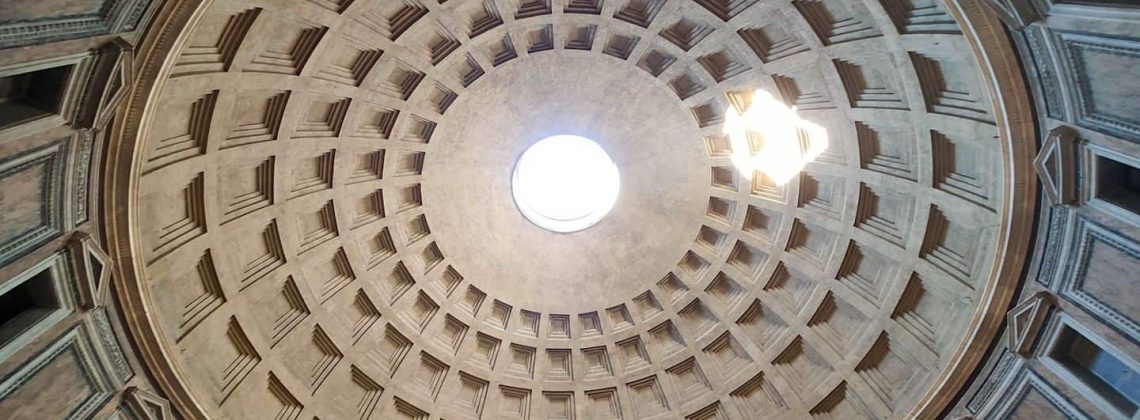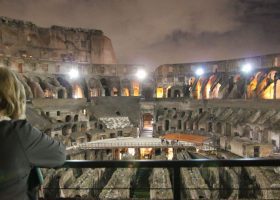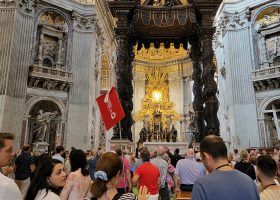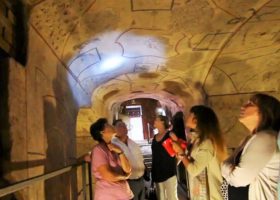This amazing building has fascinated people for the last 2,000 years. What is it exactly that attracts us to this temple/ monument/ church? As one of the most preserved buildings from antiquity, here are a few reasons why we think the Pantheon is famous and why you should visit it.
Pro Tip: It’s easier to organize your trip when you have all your resources in one place. Create a browser folder and bookmark this post. Also, check out our guide to Rome for more planning resources, our top Rome tours for a memorable trip, and the top things to do near the Pantheon.
Editors Notes: As of July 3rd, 2023, the Pantheon is charging a fee for admission. The cost is €5 for adults and free for children. Tickets can be purchased on-site. The tickets are not currently available online. (Updated on 7 July 2023).
What Is the Pantheon?
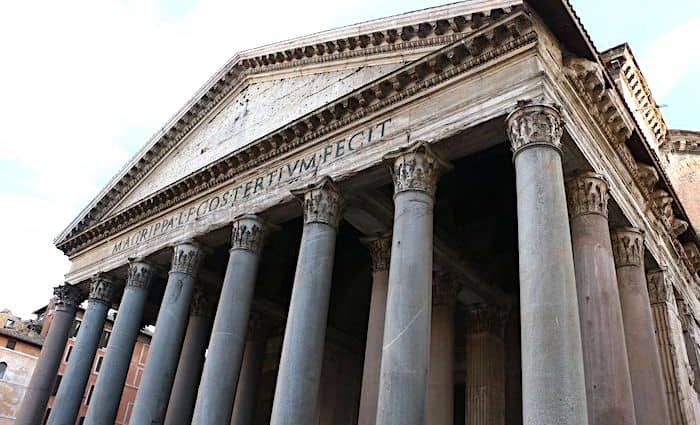
The word “pantheon” translates to all-worship or all-gods, depending on how you look at it. Contrary to what many have written on the internet, the use of the building was not to worship all pagan gods.
Pagan gods didn’t appreciate sharing a temple with other gods. There are exceptions for gods conjoined in their purposes, like Castor and Pollux. Also, a deified couple like Antonius Pius and Faustina, his wife, share a temple. But in general, the Romans built temples dedicated to a single deity.
This is one reason why the Pantheon is so famous: we’re just not sure what it was used for. What the Romans used the Pantheon for is undocumented at best. A strong theory from the Professor of Archeology, Amanda Claridge, is that the Pantheon existed for the worship of emperors yet to be deified.
It is no mystery that Romans didn’t like to worship emperors as gods until after their death. Claridge states in her Rome Archeological Guide, “The Pantheon provided a setting–not a temple in the conventional sense–in which the living emperor would appear in the company of the gods (including his own deified predecessors).
Not ready to book a tour? See if Rome Tours are worth it.
Construction and Reconstruction
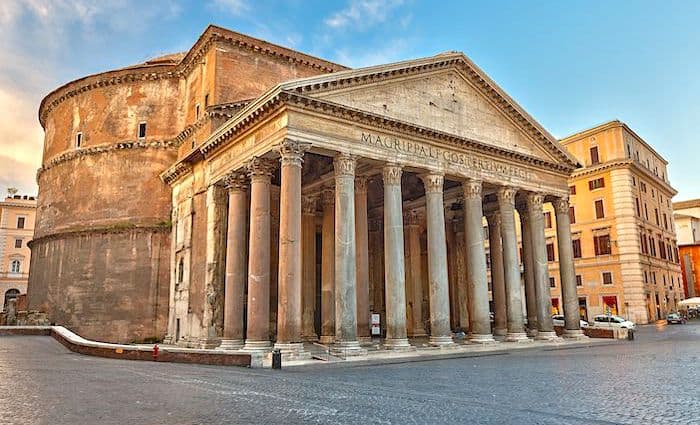
One of the reasons the Pantheon is so famous is the number of times it was rebuilt. According to Amanda Claridge, the Pantheon was first built between 27 – 25 B.C., but that building would not be recognizable today.
The first structure was built by Marcus Agrippa, who was a Roman Consul under the first Emperor of Rome, Ceaser Augustus. The original structure was built primarily out of wood and subsequently burnt down about 100 years later in A.D. 80.
Domitian took a second shot at it, but the structure was struck by lightning and burnt to the ground in A.D. 110. At the time, these incidents would have come across as very bad omens for Rome during an otherwise prosperous time. Lightening was controlled by Jupiter (Zeus), and if it struck the building, it would likely signify he was unhappy with it or the Romans in general.
Trajan, emperor at the time, likely began the third structure, and Hadrian would have finished it. Hadrian was a great emperor and very humble, so he did not dedicate the structure to himself—something he only did one time. Instead, he dedicated it to the man who originally built it: Marcus Agrippa. We’ll get to that when we go over the porch.
Who built the Pantheon? Many believe the architect responsible is Apollodorus of Damascus, but this again is speculation. We do know that Hadrian commissioned renovations on the Pantheon, which were completed between A.D. 125 and A.D. 128.
Biggest Concrete Dome in the World
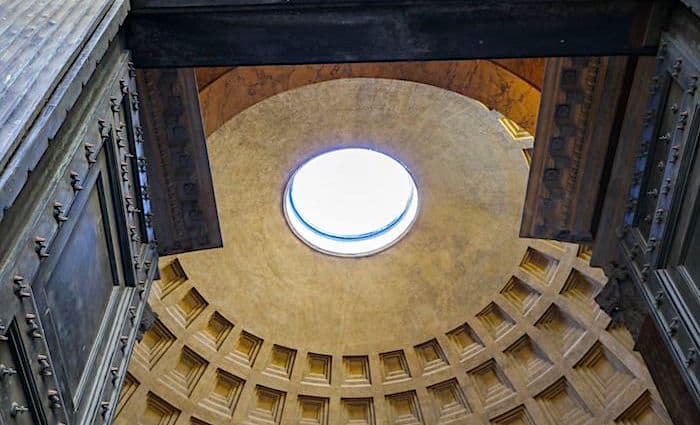
Perfection
Once you walk inside, your eyes will be drawn to the dome above you. Many people stop in the doorway, causing traffic jams, and we can’t blame them. That’s exactly the effect the architect would have longed for. The architecture of Rome was heavily focused on showing the superiority of the Romans, and the Pantheon was no different.
The dome is a perfect hemisphere, and you would be able to fit a sphere inside the structure with a diameter of 44.4 meters, which would touch the ceiling, floor, and walls. The building is perfect, and thus its construction is a mystery.
Some believe a complex scaffolding was used to lay the concrete, while others believe the entire building was filled with sand from Ostia. Today, all you can do is admire it.
The building is 145 feet (44.4 meters) tall by 145 feet (44.4 meters) wide and built completely from stone, brick, and concrete. Also, the dome is made entirely out of concrete with five rows of 28 coffers that decrease in size as you get closer to the oculus.
The Oculus
The oculus is completely open. Rain and other elements do get inside the structure when doors are closed. You’ll see the floor slopes down into the center and drains in place to allow water to leave the structure. There’s a decorated bronze ring on the interior of the oculus. There would likely have been decorative bronze fixtures in all of the 140 coffers.
Remember that the Pantheon was built 2,000 years ago. Keep that in mind as I tell you that it held the record for the largest span of concrete until 1958! The CNIT building in Paris finally beat it.
Want another record? Well, the Pantheon is also the largest unreinforced concrete dome ever built—even to this day! If this doesn’t impress you, my friends, then nothing will.
Popular Rome Tours

Best Seller
Privileged Entrance Vatican Tour with Sistine Chapel
This our most popular and longest-running Vatican tour to date. You’ll enter the Vatican Museums an hour before the public opening and see the breathtaking Sistine Chapel. Admissions are included and our English-speaking guides do a wonderful job bringing the museums to life!
See Prices
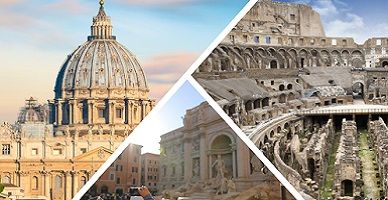
Customer Favorite
Rome in a Day Tour with Vatican, Sistine Chapel, Colosseum, and More!
Looking to get much of your sightseeing done in one day? This tour enters the Vatican an hour before opening and visits the Colosseum along with other sites like the Pantheon, Piazza Navona, and Trevi Fountain. All admissions and transportation are included as well as a licensed, English-speaking guide!
See Prices
Not ready to book a tour? Check out our best Rome tours to take and why.
Kings of Italy and An Artist Buried Inside
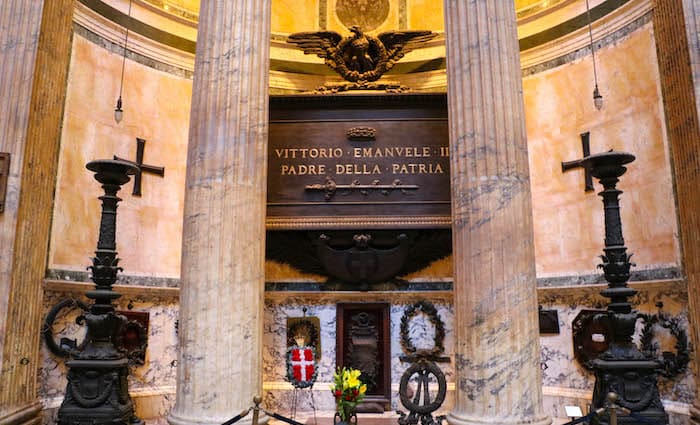
Kings of Italy
One of the reasons the Pantheon is so famous is due to the people buried inside. Vittorio Emmanuelle was a Sardinian King who successfully unified all of the sub-kingdoms of Italy to form one great nation between 1861 and 1871. He was from the Casa Savoia, which was a great noble family established in A.D. 1003. Their family still has successors today, although their titles are not recognized.
Emmanuel’s army, led by the great Giuseppe Garibaldi, successfully unified the peninsula under the rule of one monarch. Some sub-kingdoms joined peacefully, and others by force. The final stop was the battle of Castelfidardo, which is when Garibaldi fought and was victorious over the papal forces. The idea of the Catholic church controlling armies is extremely foreign to us today.
Victor Emmanuel II died in 1878 and was buried in the Pantheon. His tomb reads Padre della Patria, which translates to the “Father of the Fatherland.” The fact that he was allowed to be buried here is a mystery.
Pope Pius IX refused to meet with Emmanuel after he overtook Rome and never acknowledged his reign. Then, he allowed him to be buried inside the Pantheon, a Catholic Church. Umberto I, the second and last King of Italy and also a Savoia, is buried in the same tomb.
The Famous Painter Raphael
Raphael’s tomb is on the back left-hand side of the structure. He’s buried next to his fiancée Maria Bibbiena, which was not by his design. He was madly in love with Margherita Lute—a baker’s daughter and the subject of many of his works of art, including La Fornarina (Palazzo Barberini), which translates literally to the baker’s daughter.
Raphael, who lived from 1483 to 1520 and may have died on his birthday, is located under a statue of Mary holding baby Jesus to her left, which was done by an artist named Lorenzetto.
His tomb reads ILLE HIC EST RAFFAEL, TIMUIT QUO SOSPITE VINCI, RERUM MAGNA PARENS ET MORIENTE MORI. Translated by Alexander Pope, it reads, “Living, great nature feared he might outvie Her works; and, dying, fears herself may die.”
It Has Been a Church for 1,400 years!
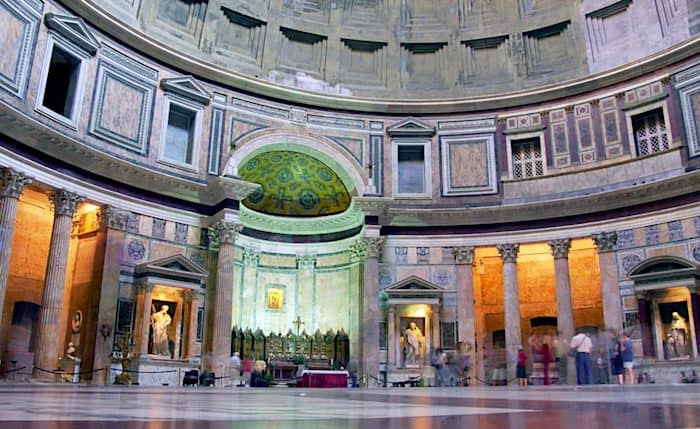
One of the most astonishing facts about the Pantheon is its survival. In A.D. 609, the Pantheon was converted into a church by Pope Boniface IV. A rough history states that Christians complained about being plagued by pagan ghosts haunting the building, so it was then converted to a church.
This is the principal reason that the building is still standing today and why the Pantheon is so famous. Many other ancient Roman buildings were built to withstand time, but not the recycling of their building material. Once it was a church, nobody was allowed to loot it. It is still a church today and is called St. Mary and the Martyrs.
Most of the Original Decoration Was Recycled
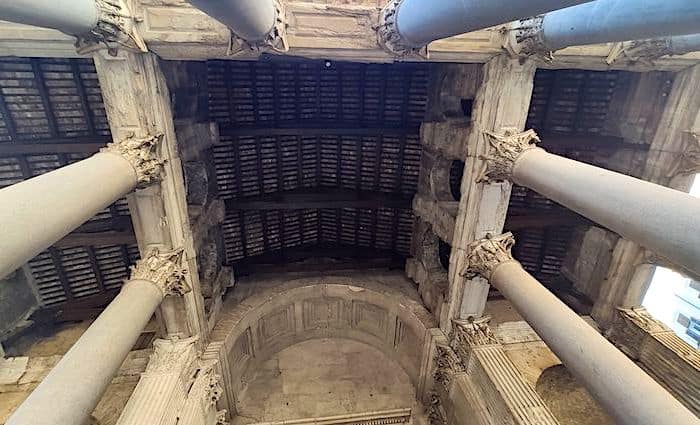
The Pantheon has been famous over the centuries not always in a good way. The fact that it was turned into a church most definitely saved the Pantheon from being destroyed over the centuries. However, that doesn’t mean that it couldn’t be stripped of its most precious metals and marbles!
In the 17th century, Pope Urban VIII (Barberini) ordered significant material to be taken from the Pantheon, including bronze adorning the ceiling of the portico. This is where the phrase, “What the barbarians did not do the Barberini did” comes from.
It refers to the barbarians who sacked Rome in antiquity, taking most of its wealth. The bronze was used for Bernini’s famous Baldacchino in St. Peter’s Basilica.
The Porch Isn’t The Right Size
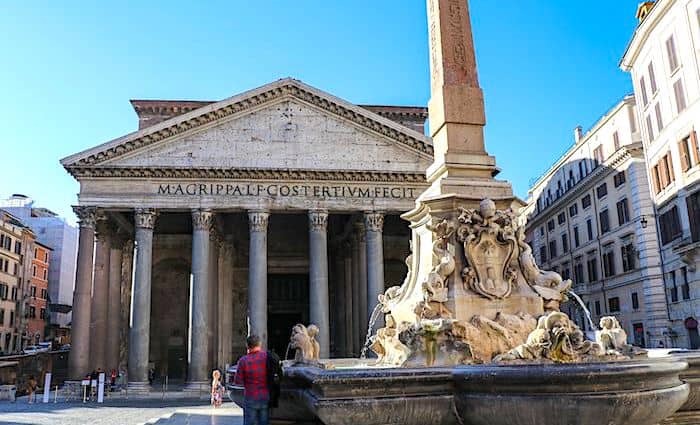
The porch is significantly different from the inner drum. It is quite literally the square peg and round hole dilemma. Many speculate as to why the building’s porch design does not match the width of the drum.
If you look directly at the structure, you can see the drum behind the porch which, for a lack of better words, makes the exterior look ugly. Some think this was due to a shortage of materials during construction or even a shipwreck that caused the loss of some columns from Egypt.
The Facade and Doors
It’s still a classical and monumental entrance. The support columns are monolithic shafts of Egyptian granite that sit on a base of white Pentelic marble. The exterior of the building would also have been completely clad with marble—the Romans would not have designed the structure with a brick exterior.
The triangular facade shows many marks that lead us to believe there must have been a frieze on the front. Imagine a massive eagle in a victorious wreath—the symbol of Rome and Jupiter. You’ll see small holes that would have adjoined the frieze to the facade.
Also, notice there are four pink Aswan marble columns in the middle of the porch. These columns were added in the 17th century after some damage and are not original to the building.
The bronze doors, although ancient for us, are not original to the building. They were likely added in the 15th century when Rome was coming out of the darkness of the Middle Ages.
If you’re a history nerd like us, you’ll love our Rome in a Day tour, which explores the Pantheon and other top Rome sites. You could just read more about the Pantheon’s history, but nothing beats seeing it in person with a passionate local guide who loves history as much as you!
Not ready to book a tour? See if Rome Tours are worth it.
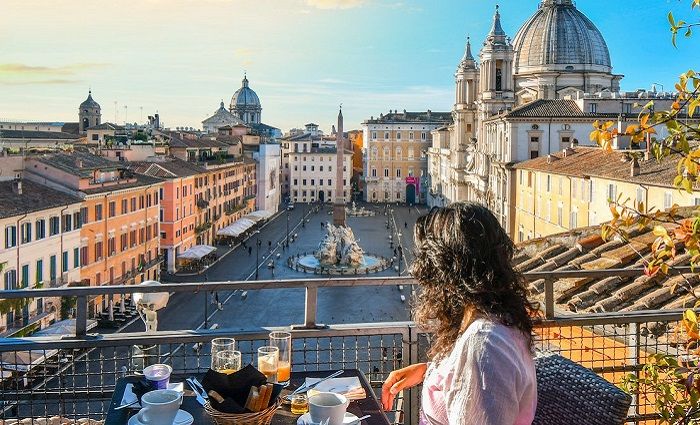
Where To Stay in Rome
Rome has a rich cultural history and many iconic landmarks to explore. Plan where to stay in the magnificent Eternal City in the best neighborhoods.

